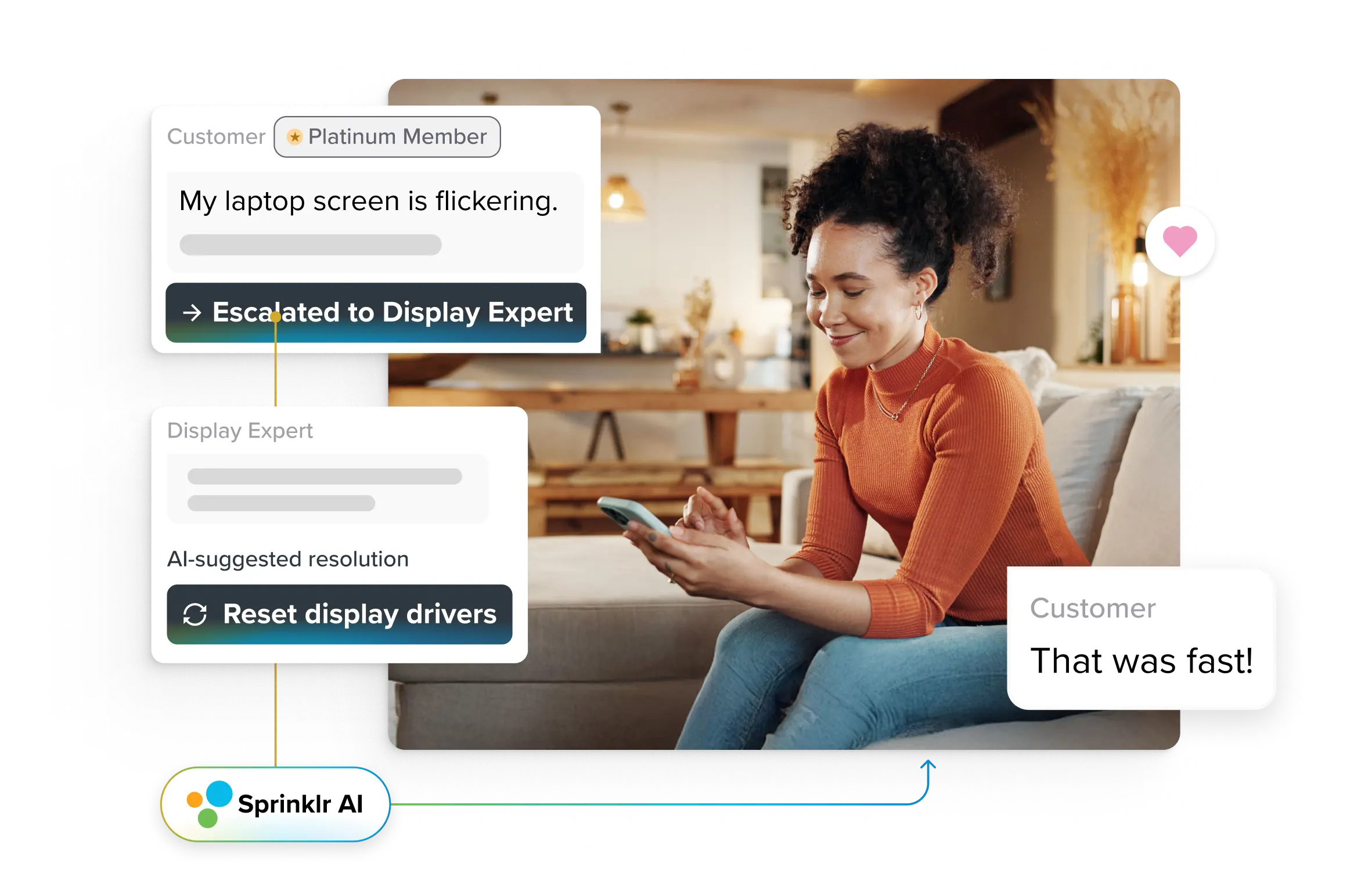Transform CX with AI at the core of every interaction
Unify fragmented interactions across 30+ voice, social and digital channels with an AI-native customer experience platform. Deliver consistent, extraordinary brand experiences at scale.

Multilingual Customer Support: A Guide to Provide and Improve It
Thank you for calling ABC Corporation.
Press 1 for English.
Press 2 for Spanish.
Press 3 for French.
Customer: (presses 3)
Agent: Bonjour! Je m'appelle Camille. Comment puis-je vous aider aujourd'hui ?
In this scenario, the customer chose French because they could best communicate their needs in their native language. This choice might seem small, but it speaks volumes about a business’s customer-oriented approach — prioritizing the customer’s comfort rather than forcing them to adapt.
When you offer multilingual support, you’re more than just accessible; you’re truly global. Today, multilingual support is necessary for any business with international operations.
But is implementing multilingual support as straightforward as it seems? Sure, it starts with a simple call or message, but there’s a lot happening in the background — like the tech stack that connects a French-speaking customer to a French-speaking agent.
In this blog, we’ll explore the inner workings of multilingual support, its benefits, the challenges businesses face and expert tips for successfully navigating them.
What is multilingual customer support?
Multilingual customer support assists customers in multiple languages, ensuring they can effectively communicate and address their concerns in their preferred language. It's about bridging the language barrier between you and your diverse customer base, creating a more seamless and inclusive experience for all.
Global businesses recognize that catering to a worldwide audience means going beyond English to create a more inclusive experience for diverse markets. Even if you're focusing on the US market alone, consider this: around 68 million people speak a language other than English at home, which is nearly 20% of the population, according to Slator.
By making multilingual customer service more accessible, you can reduce misunderstandings, improve first-call resolutions, minimize escalations and create a more satisfying customer experience.
Key multilingual customer support channels
Almost every communication channel businesses use today can be optimized to offer multilingual support. Here’s how they work:
📞 Phone support: Direct calls remain one of the most personal ways to resolve customer issues. With the help of an interactive voice response (IVR) system, you can route customers to agents who speak their preferred language, ensuring they feel understood and supported from the moment they connect.
📧 Email support: Emails allow customers to lay out detailed concerns in their native language. Modern email management tools can route these emails to agents fluent in the respective language, guaranteeing clear communication and faster resolution times.
💬 Live chat support: Today’s customers often prefer the immediacy of live chat. Offering multilingual live chat support can prevent language barriers from slowing down resolutions, so customers get quick help directly on your site or app hassle-free.
💌 Social media support: Platforms like X (formerly Twitter), Facebook and Instagram have become central to customer service. Providing multilingual support on these platforms means customers can reach out in the language they’re comfortable with —building a stronger connection and a more relatable brand experience.
📑 Self-service resources: For customers who like to troubleshoot on their own, FAQs, help docs and video tutorials in multiple languages make all the difference. This support lets customers find solutions independently without contacting a representative, empowering them with the necessary resources.
Benefits of multilingual customer support
Multilingual customer support brings tangible and intangible benefits to your business, helping resolve issues you might have struggled with for a long time. Let’s explore how.
Ensures an effortless customer experience
A whopping 89% of businesses will compete mainly on customer experience. Customers shouldn’t struggle to express themselves or understand your services. Multilingual support is crucial in delivering a seamless experience by allowing customers to interact in their preferred language, reducing the chances of miscommunication. This ease fosters quicker issue resolution and ensures higher satisfaction.
Consider Microsoft, for instance. The tech giant provides customer support in multiple languages across its products, ensuring users from different regions can get help in their preferred language. This multilingual strategy ensures effortless interaction and keeps customers engaged and satisfied.
Reduces churn and increases retention
About 70% of leaders aim to deploy technology to tap into the voice of the customer and enhance their customer experience. Multilingual customer support shows customers you value their preferences. Providing this level of accessibility ensures customers feel heard, reducing frustration and ultimately improving customer retention.
Personalizes CX and provides a competitive edge
Brands that provide a high level of personalization enjoy 1.5 times greater customer loyalty than those that do not. Engaging with customers in their preferred languages is the most effective form of personalization, as it fosters trust and loyalty while offering a significant competitive advantage over time.
📚Read More: Personalized Customer Experience: Top 4 Ideas + Examples
How to provide multilingual customer support [+Expert tips]
Here is a step-by-step guide to help you implement effective multilingual support.
Step 1️⃣: Assess your audience’s language needs
Effective multilingual customer support begins with a deep understanding of your audience. Market research is your best ally here, helping you identify the primary languages your valued customers speak. Start by analyzing website analytics, customer inquiries and social media interactions to gain insights into their language preferences. This data will paint a clearer picture of which languages matter most to your customer base, enabling you to tailor your support strategy accordingly.
🎯Pro Tip
Want to know exactly which languages to prioritize? Start by running customer surveys through websites or in-app popups that ask customers about their preferred support languages. This direct feedback aligns your multilingual strategy with real customer needs, helping you invest resources where they’ll have the most impact.
Also, make sure your surveys are available in multiple languages! Offering multilingual surveys shows customers you’re committed to inclusivity and personalizing their experience from the start.
Step 2️⃣: Hire and train multilingual staff
Once you know your audience’s language needs, hiring and training multilingual staff is the next step. But it’s not just about language fluency — it’s also about understanding cultural nuances and communication styles so customers feel truly understood and supported.
Look for candidates fluent in both the language and the culture they’ll be serving. This cultural knowledge helps them adapt to subtleties in tone and etiquette, delivering a customer experience that feels familiar and comfortable. And don’t stop there — ongoing training is essential. Equip your agents with customer service skills to handle challenging situations with empathy and professionalism, ensuring your multilingual support is as seamless and effective as possible.
🔖Do not miss: Customer service training: A much-needed guide for 2024
Step 3️⃣: Leverage AI-powered translation tools
Language barriers can pose challenges, but AI-powered translation tools are changing the game. Real-time translation software, integrated with chat and email platforms, allows your team to bridge language gaps instantly, even for languages your team may not cover directly. These tools often extend to social media, enabling your team to handle customer queries in multiple languages without missing a beat.
By using AI-driven translations, you can scale your multilingual support, maintain consistency, and ensure that customers feel understood no matter where they’re reaching out from. As these tools continue to advance, they’re becoming better at handling complex phrases and regional nuances, adding depth to your customer interactions.
Step 4️⃣: Deploy a multilingual chatbot
Deploying an AI-powered chatbot that supports multiple languages is a game-changer for providing instant, around-the-clock support. By integrating a multilingual chatbot, you can help resolve common customer issues in real-time, in their preferred language, without making them wait. These bots can handle initial queries, direct users to the right resources or even escalate complex cases to the appropriate language-specific agents— ensuring a seamless experience across languages.
To ensure your customer service chatbot is effective, choose a solution that can automatically detect the customer's language or allow them to select their preferred language from the start. Regularly update your bot's language capabilities to reflect customer feedback and ensure it can accommodate evolving regional nuances and industry-specific terms.
💡Do you know
With Sprinklr’s conversational AI platform, you can quickly build and deploy a multilingual chatbot across 25+ channels (including voice) in 100+ languages.
Powered by Sprinklr AI+, these bots handle requests dynamically and even resume conversations after interruptions, delivering an incredibly human-like experience. Whether resolving a query or escalating an issue, Sprinklr ensures your multilingual support remains consistent, effective, and scalable.


Step 5️⃣ Create multilingual self-service resources
Not every customer wants to wait for an agent; some prefer to troubleshoot issues independently. That’s where multilingual self-service options come in. Start by deploying a multilingual FAQ chatbot. This empowers customers to resolve common problems independently, reducing your support team’s workload while boosting customer satisfaction.
Another valuable option is building a multilingual knowledge base. A well-maintained, multilingual knowledge base allows customers to access support in various formats — text, audio and video — giving them the tools to thoroughly understand your product or service. When kept up-to-date, this extensive resource can simplify complex offerings and expand your reach to a diverse, global audience.
😊 Good to know
Modern knowledge base software goes beyond traditional resources by embedding conversational bots that access and learn from your content to quickly resolve standard customer queries — helping clear your ticket queue in the process.

Step 6️⃣ Leverage conversational voice bots
In the age of Siri and Alexa, customers expect low-effort, intuitive support — and conversational voice bots deliver just that. With AI-powered multilingual capabilities, these bots let customers speak their preferred language, tackle issues instantly, and even switch to chat or email mid-conversation. It’s fast, it’s flexible and it gives customers control, so your support stays effortless and engaging at every step.
Step 7️⃣ Partner with third-party language service providers
Building an in-house multilingual team is ideal, but there are times when extra support is essential. Partnering with third-party language service providers can help fill these gaps, especially during peak periods or as you expand into new markets.
These providers bring a team of language experts to your side, delivering top-tier customer support in multiple languages without compromising quality. Whether for overflow support or handling specialized languages, partnering with language service providers is a reliable solution when your team is stretched thin.
🎤 Expert insight
When choosing a language service provider, prioritize cultural competency alongside language fluency. A provider with strong cultural insights will make customer interactions feel more authentic and engaging, leading to stronger customer satisfaction and loyalty.
Common multilingual customer support challenges with solutions
As powerful as multilingual support can be for customer satisfaction and loyalty, it’s not without challenges. Here’s a look at some common obstacles and how to overcome them for seamless global customer service.
🔁 Maintaining consistency across languages
With multiple languages in play, ensuring consistency in your messaging, tone and information can be tricky. This can lead to misunderstandings or mixed messages that affect the customer experience.
Solution: Use a centralized knowledge base software where all resources are stored and regularly updated. Additionally, train agents to adhere to brand tone and terminology standards. Tools like translation memory systems can help retain consistency across languages by keeping a record of previously translated phrases, ensuring continuity and reducing translation errors.
🏅 Managing quality with machine translation
AI-powered translation tools are handy, but they’re not flawless. Machine translation can struggle with nuanced expressions or industry-specific terms, leading to confusion or incorrect responses.
Solution: Deploy AI translation tools with human review for quality assurance. Using human-in-the-loop (HITL) systems can help bridge the gaps, with bilingual agents or language specialists reviewing critical translations. Regularly updating the AI’s vocabulary with industry-relevant terms can improve its accuracy.
🌏 Handling regional dialects and cultural differences
Even within the same language, regional dialects and cultural nuances can affect how your message is received. Customers may feel misunderstood if interactions don’t align with their local context.
Solution: Train your team to be aware of regional nuances, especially for languages with diverse dialects, like Spanish or Arabic. Partnering with culturally aware language providers can help, as can continuous learning sessions for in-house agents on regional expressions and cultural norms.
💵 Managing costs of multilingual support
Hiring multilingual staff, translating resources, and investing in specialized tools can add up quickly, especially for businesses that need to support a large number of languages.
Solution: Start by focusing on the most-requested languages and gradually scale based on customer demand. Leveraging AI translation tools for high-volume interactions and reserving human agents for complex cases can help balance cost-efficiency with quality.
Elevate your brand’s global reach with Sprinklr Service
Adopting a global mindset is critical to scaling your business, even if you're not thinking globally. Multilingual customer support shows you're ready to serve a diverse audience and grow beyond local borders. But here's the thing — we live in an AI-driven world now. Relying solely on your support agents won't cut it anymore. You need something more reliable, like Sprinklr Service.
With Sprinklr's complete customer service suite, you'll have everything you need to deliver seamless multilingual support: AI-powered chat, call management, smart omnichannel routing and deep analytics. As an all-in-one platform, Sprinklr empowers your brand to connect with customers in their preferred language while elevating the entire support experience.
Leading brands trust Sprinklr to manage their global customer support. Schedule your free demo today to discover how you can transform your customer experience.
Frequently Asked Questions
Start by analyzing your customer base. Use analytics tools to identify the primary languages spoken by your audience. Focus on regions where your products or services are most popular. Customer surveys and website traffic data can also give valuable insights. Prioritize languages based on demand and market potential.
Use standardized support scripts and guidelines to ensure consistency. Train all agents on the same processes and values regardless of language. Invest in AI-powered translation tools for uniform responses. Regular quality checks and feedback sessions help ensure that service levels remain consistent across all languages.
AI translation tools can handle routine inquiries, leaving complex tasks to human agents. Integrate these tools with your CRM so agents get real-time translations. Ensure agents are trained to spot inaccuracies in machine translations and take over when needed. This human-AI collaboration enhances efficiency without sacrificing accuracy.
To attract top talent, offer competitive salaries and career growth opportunities. Invest in continuous training programs to enhance language skills and customer service expertise. Recognize and reward exceptional performance. A supportive work environment and clear advancement paths can help retain multilingual staff.
Cultural sensitivity goes beyond translation. Hire agents who understand your customers' cultural context. Train your team on local customs, communication styles and expectations. Adapt your marketing and support content to be relevant to each region, ensuring a respectful and tailored customer experience.
When scaling, consider language demand, local regulations and cultural nuances. Invest in scalable technologies like AI-powered chatbots and real-time translation tools. Ensure your team grows proportionately to meet the increasing demand. Finally, conduct regular assessments to refine your processes as new markets evolve.












